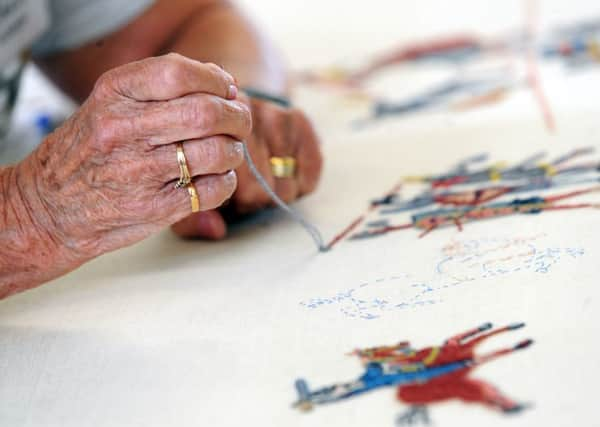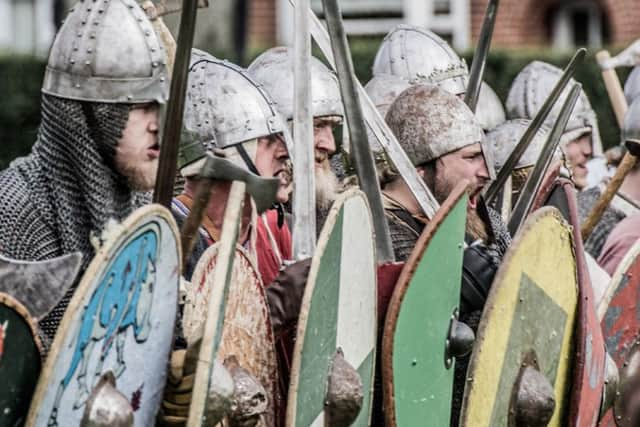Woven into history: Yorkshire's answer to the Bayeux Tapestry


Those modern quirks aside, the project does have a serious aim and it follows on from a similar project a few years ago to create an embroidered history of the Battle of Fulford, which took place just a few miles down the road.
“Stamford Bridge was a hugely important battle,” says Chris. “But because of what happened at Hastings it’s always been overshadowed. There is also so much misinformation surrounding the events of 1066. Some people think it was the Normans against the Saxons, others the Viking against the Normans. The tapestry seemed like a good way to tell people as much as we know.”
Advertisement
Hide AdAdvertisement
Hide AdThe story of the Battle of Stamford Bridge begins on September 20, 1066 when a fleet of 300 Viking ships sailed up the Humber, moored at Riccall and marched on to Fulford, just outside York. The forces of York fought bravely, but were quickly overcome and the Viking leader Harald Hardrada declared himself ruler of York. News of the defeat soon reached Harold Godwinson, the Saxon King of England, who started north, collecting troops along the way. In four days, he covered the 180 miles from London to Tadcaster and went onwards to Stamford Bridge where intelligence told him the Viking army was resting.


“When they saw a cloud of dust on the horizon the Viking troops assumed it was fellow soldiers bringing the hostages from York, but they soon realised that it was a Saxon attack,” says Chris. “Estimates suggest that there were 15,000 Saxons against 20,000 Vikings. So many men died that 50 years later the site was described as being ‘white with bones’. Harald was killed and the Vikings who had arrived in 300 ships returned to Norway in just 24.”
However, Harold’s victory celebrations were short lived. He and his troops were exhausted and by they time they had made the return journey south many were on the brink of collapse.
“There was no time to recover and they spent another seven days marching onto Hastings. It was hardly surprising that on October 14 they lost, albeit narrowly, to Norman invaders. That day British history was changed for ever, but had they not been forced to fight at Stamford Bridge things could have been very different.”
Advertisement
Hide AdAdvertisement
Hide AdThe tapestry is being embroidered by a group of volunteers who meet every Wednesday morning at the local community centre. Some have years of experience in needlepoint. Most were just novices when they began, but all have a desire to put this corner of Yorkshire on the map.


“I moved to York not so long ago,” says Heather Cawte. “I’m really interested in history and was looking for a project that I might be able to help out with. When I read about the tapestry, I knew that was it. The design Chris has done is fantastic. It’s incredibly authentic and pays homage to the Bayeux Tapestry, but it also has a character very much of its own. We’ve now got quite a community of embroiderers and I think that when the day comes that we can see all of the panels displayed together we will all be incredibly proud.”
The project has taken on even greater significance following the death of Tom Wyles, who co-founded the society with Chris and who worked tirelessly to promote awareness of the crucial role the village played in English history.
“Tom was a real driving force of everything that happened in Stamford Bridge and he was taken from us far too young,” adds Heather. “The tapestry will now be our way of paying tribute to him and everything he did for the village.”
Advertisement
Hide AdAdvertisement
Hide AdNext weekend the 950th anniversary of the battle will be marked by a two-day celebration featuring re-enactments, living history demonstrations and falconry and archery displays. On the Sunday there will also be a processional ride from York to Stamford Bridge by mounted warriors to be followed by an evening firework display.
“Everyone has heard of the Battle of Hastings, but if you say Stamford Bridge to most people they will immediately think of Chelsea Football Club. This is our way of reclaiming our chapter in history and it would be lovely to think that in years to come we might be able to display our tapestry alongside not only the one completed at Fulford, but the Bayeux Tapestry. Now that would be some achievement.”
The Battle of Stamford Bridge 950th anniversary weekend re-enactment will take place on September 24 and 25. For more details go to thebattleofstamfordbridge.blogspot.co.uk